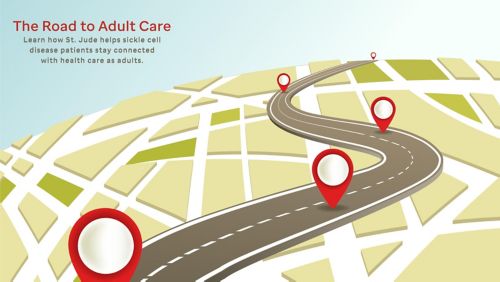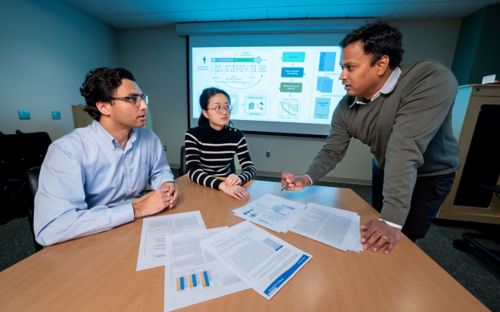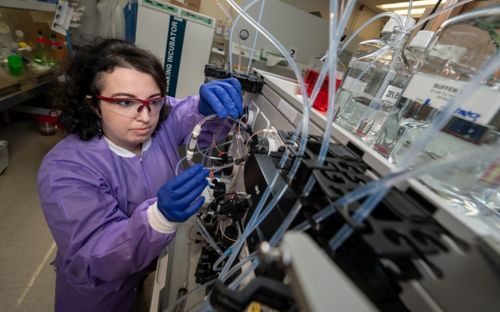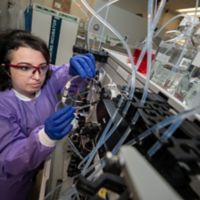St. Jude advice to young adults with sickle cell disease: Stay connected

St. Jude is helping people with sickle cell disease make the transition from pediatric to adult care.
Growing up is exciting and sometimes terrifying. The independence that comes with age brings more responsibility for everything from school and work to money and health care. Add a chronic illness such as sickle cell disease to the mix and the challenges are even greater and the stakes higher.
Which is why, 15 years ago, St. Jude Children’s Research Hospital created a transition program to ensure the hospital’s patients with sickle cell disease stay connected with health care as adults. “The majority of patients used to abandon care after aging out of pediatric care,” said Jane Hankins, MD, medical director of the St. Jude Pediatric Sickle Cell Program.
“When this happens, outcomes are worse for patients; they are hospitalized more often, their disease gets more severe and some die. Keeping patients engaged in their care is key,” said Marquita Nelson, MD, of the University of Tennessee Health Science Center and the Methodist Comprehensive Sickle Cell Center. In 2016, St. Jude and Methodist created the St. Jude-Methodist Sickle Cell Disease Transition Clinic to ease the transition from pediatric to adult care.
St. Jude cares for about 900 Mid-South children with sickle cell disease. Each year about 40 of those St. Jude patients with sickle cell transition to adult care.
There is evidence the effort is helping to keep adolescents more engaged in their health care and improves their quality of life as young adults, Hankins said. In 2021, almost every St. Jude sickle cell patient had made an appointment with an adult health care provider within a year of graduating from pediatric care.
The transition program continues to grow its staff and services. The effort also serves as the model for transition programs St. Jude is piloting in the Brazilian cities of Sao Paulo and Rio de Janeiro.
Survival of children and teens with sickle cell has increased
There are 80,000 to 100,000 people in the United States with sickle cell disease. In the U.S. the condition is most common among people of African ancestry. The inherited disorder affects red blood cells, which ferry oxygen throughout the body. Normal red blood cells contain hemoglobin A. People with sickle cell disease have red blood cells that contain mostly the abnormal hemoglobin S. These red blood cells become sickle-shaped (crescent-shaped) and have difficulty passing through small blood vessels. As a result, people with sickle cell disease are at increased risk for anemia, infections, stroke, recurring episodes of severe acute and chronic pain, progressive organ damage and early death.
While blood stem cell (bone marrow) transplantation will cure sickle cell disease, the treatment is not an available option for most patients due to the difficulties of finding and obtaining matched donors.
In the last five decades, newborn screening, vaccination, medications such as penicillin and hydroxyurea along with better supportive care have helped push survival rates for children and adolescents from 50% to about 95%. But survival rates in adults have not kept up. Overall life expectancy for people with sickle cell disease is about 20 years less than Black Americans without the condition.
Keeping young adults plugged into care
When the sickle cell diseases transition program began in 2007, the goal was to make sure 12- to 18-year-old patients understood the condition, knew how to manage pain crises and other complications and recognized the importance of regular medical care. The effort soon expanded to include visits to Memphis adult health care providers and hospitals; screens for attention and memory deficits; plus help with navigating health insurance, refilling prescriptions and other life skills
The program has continued to grow. It serves sickle cell patients ages 18- to 25-years-old. St. Jude and Methodist doctors and staff now travel between the sickle cell programs each week to see patients who are making the move from pediatric to adult care. Ugochi Ogu, MD, of the Regional One Heath Diggs Kraus Sickle Cell Center, alternates weeks with Nelson seeing patients at the St. Jude Teen Clinic.
“The staff is the bridge between the programs,” Hankins said. The list includes a Methodist patient navigator, neuropsychologist Jennifer Longoria, PhD, of the St. Jude Psychology Department, and case manager Shelia Anderson. Anderson has worked with St. Jude hematology patients since 2005.
“It takes some patients awhile to get engaged with their health care,” she said. “But now if patients don’t show up for a visit, we’ll send them letters and work with them to remove roadblocks to care, such as transportation or insurance.
“Before the transition program, maybe 30 or 40% [of patients] established care with an adult provider after leaving pediatric care, even though St. Jude provided them with provider names, phone numbers and addresses.
“Now 90% plus of patients come to their first adult appointment within a year,” Anderson said.






